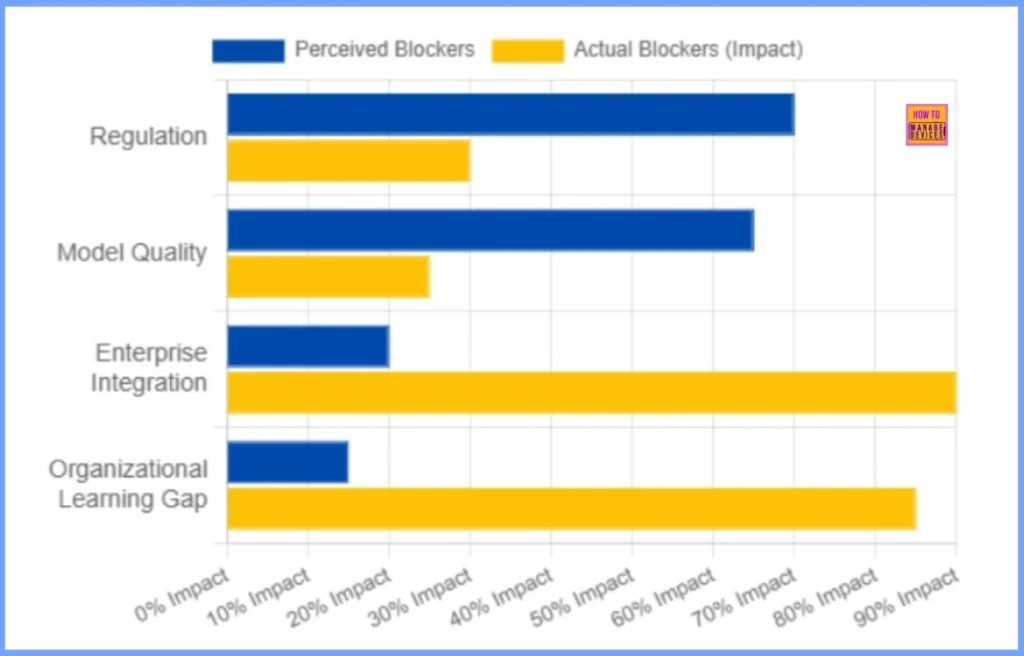Why Is Enterprise AI Rollout Stuck? Transformational Strategy or Just Small Steps? Most companies are spending a lot of money on Generative AI, but the results are not matching the expectations. According to MIT, 95% of big AI projects are failing because they are not giving any real business results.
Only a small group of companies about 5% are able to use AI in a serious way and get big financial benefits. This big difference is called the “GenAI Divide.” The main reason for this divide is the gap between using AI and getting real impact from AI. Many companies are using tools like ChatGPT and Microsoft Copilot .
These tools help employees write faster, summarise documents, or code quickly. This makes individuals more productive, but it does not change how the company works overall. On the other hand, big enterprise AI systems which can save huge costs or change major processes are not being used fully. Only 5% of them reach actual production.
Some surveys indicate that companies are achieving a 74% to 136% Return on Investment (ROI) from AI, but these numbers are derived from small, everyday benefits rather than significant business changes. These surveys primarily measure the impact of simple tools like ChatGPT and Copilot, which help employees write more efficiently, summarise information, or accelerate coding.

Table of Contents
Why are Most Enterprise AI projects Stuck in the Pilot Phase?
Many companies start AI projects but cannot move past the trial stage because no one clearly owns the project, the data is not clean or ready, and the company is not prepared to change its existing processes. Because of these problems, the AI pilot stays a pilot and never becomes fully used in the organization.
What’s the Difference between Incremental AI and Transformational AI?
Incremental AI refers to small improvements that help employees work a little faster, like writing emails quickly, summarising content, or automating simple tasks. Transformational AI, on the other hand, involves major changes such as redesigning workflows, automating entire processes, or saving large amounts of money.
If AI Tools Like Copilot and ChatGPT are Widely used, Why is ROI Still Low?
These tools help individuals, not the entire organisation. They save time but do not create major financial impact or redesign core business processes.
Why Is Enterprise AI Rollout Stuck? Transformational Strategy or Just Small Steps?
ROI (Return on Investment) is a simple financial metric used to measure how much profit or value you gain from an investment compared to what you spent on it. It helps you understand whether an investment such as a project, tool, service, or training is actually worth the money, time, and effort put into it.

- How to use Intune Explorer with Security Copilot to Find Windows and MacOS Device Data across your Tenant
- How to Get Managed App ID Last modified Date App Version Details of Built-in Android App using Intune Copilot Explorer
- Quickly Identify All Android Devices Enrolled in Intune with Copilot Explorer
- How to Get Android Work Profile Device Configuration Policies with Intune Explorer and Security Copilot
- How to Retrieve General Device Configuration Policies for Android Device Owner using Intune Copilot Explorer
The Real Barriers to Scaling Enterprise AI: The Integration Gap and the Learning Gap
Most companies think their AI pilots fail because of external issues like strict regulations or limitations of AI models. However, MIT’s research shows the real blockers are internal. The two main reasons AI projects get stuck in “pilot hell” are:
- A major Integration Gap, where AI systems cannot connect properly with real business workflows, and
- A major Learning Gap, where both the organization and the AI systems fail to learn, adapt, and improve.
- Together, these gaps stop AI pilots from becoming fully functional enterprise solutions.
Most Companies Spend their AI Budgets in the Wrong Areas
MIT’s research shows that over half of enterprise AI investments go into Sales and Marketing, because these functions look more visible and easy to measure. But the real, proven ROI comes from back-office automationareas like finance, procurement, and operations where repetitive processes, BPO spending, and manual workflows can be reduced at scale.
The top 5% of successful companies treat AI as a process automation engine, not just a content tool, and unlock millions in annual savings. This mismatch between where companies invest and where AI actually creates value is the core reason why most projects stay stuck in pilots.
| Typical Budget Spend (95%) | ROI Result | High-ROI Focus (5%) | Proven Financial Impact |
|---|---|---|---|
| 50–70% on Sales & Marketing | Hard to measure; low P&L impact | Back-office automation (Finance, Procurement, Operations) | ₹16–₹80 crore (USD $2–$10M) in BPO/agency cost reduction |
| 30–50% on R&D, IT, other functions | Stuck in pilots; brittle workflows | IT & app modernization (e.g., code generation) | 30% faster code creation, 10% productivity boost |
Need Further Assistance or Have Technical Questions?
Join the LinkedIn Page and Telegram group to get the latest step-by-step guides and news updates. Join our Meetup Page to participate in User group meetings. Also, Join the WhatsApp Community to get the latest news on Microsoft Technologies. We are there on Reddit as well.
Author
Anoop C Nair has been Microsoft MVP from 2015 onwards for 10 consecutive years! He is a Workplace Solution Architect with more than 22+ years of experience in Workplace technologies. He is also a Blogger, Speaker, and Local User Group Community leader. His primary focus is on Device Management technologies like SCCM and Intune. He writes about technologies like Intune, SCCM, Windows, Cloud PC, Windows, Entra, Microsoft Security, Career, etc.
